Hi All
I've been doing quite a bit of work with another member - Cottage Rose and trying to 'de-code' the genetics for colours and patterns in Sebastopols. My thanks to the members of the Sebastopol Geese Lovers Forum for their support and kind permission for use of pictures. Of course the genetics apply to other breeds of geese too and we have applied it to our Dewlap Toulouse to help develop our breeding programme for Buffs. I've done my best to explain and hope other members on BYC find it useful in their own breeding programmes.
Pete

GENETICS FOR COLOUR AND PATTERNS
In Sebastopol Geese their sex, pattern and colour is determined by the parent birds. The information for inheritance is carried on the genes and this makes up the genetic code for that bird (its Genotype). However, depending upon how these are inherited from the parents determines the visual appearance of the bird (its Phenotype).
In Geese the sex chromosomes can actually influence the phenotype of the bird as some of the genes for colour and pattern are sex-linked. For example the gene responsible for Buff is carried on the male chromosome only. To further complicate matters, in birds the sex chromosomes act differently than in most other mammals including ourselves.
In humans the sex of a child is determined by the fathers sperm. The genetic code being XY which means there are either X sperm or Y sperm. In females the genetic code is XX which means there are only X eggs. Therefore in an X egg combines with an X sperm then the code will be XX meaning a female. If another X egg combines with a Y sperm then the code will be XY a male.
In birds the sex chromosomes are coded Z and W but act in an opposite manner to ourselves. In a Gander their genetic code for sex is ZZ and in a Goose their code is ZW. So in the case of our geese it is the female which selects the sex of the offspring. Her eggs are either Z or W in equal ratios. The male can only produce Z sperm. So if the Z sperm fertilises a Z egg then a male will result and if the Z sperm fertilises a W egg then a female will result.
Having demonstrated how the sex chromosomes work in birds the next step is to look at the genes responsible for colour and pattern in geese which of course includes Sebastopols. Basically all patterns and colours are derived from a set of only four gene pairs. Like all genes they work in pairs with a single gene inherited from each parent. However it is the variation in combination of the genes that gives rise to a wide range of colours and patterns. These four genes are described as follows;
Dilution Gene coded Sd (partially dominant sex linked gene)
Spotting Gene coded Sp (recessive sex linked gene)
Blue Gene coded Bl (partially dominant gene)
Buff Gene coded G (recessive sex linked gene)
All of the genes above are sex linked except the Blue gene. This means the genes for dilution, spotting and buff are all carried by the Z chromosome and the Blue gene is carried independently of the sex chromosomes.
The Buff and the Spotting gene are both recessive sex linked genes. This means that they are carried on the Z sex chromosome. In order to show visually all the birds Z chromosomes must carry a recessive form of these genes. So in the case of a female whose genotype for sex is ZW then only one recessive gene that is linked to the Z chromosome is required for the effect to show visually. In the case of a male with two Z chromosomes then both genes must carry the recessive gene for the effect to show visually. If only one of the Z chromosomes carries a recessive gene then the male will carry (or be split for) the recessive gene in its genotype but its phenotype remains the same. Using the Buff gene (G) as an example the genotype can be written and its phenotype interpreted.
Z,Z, G, G (normal male) visually Grey
Z, Z, G, g (male split for buff) visual grey but carries the recessive buff gene (g).
Z, Z, g, g (buff male) visually buff as both Z chromosomes have the recessive gene (g, g).
Z, W, G (normal female) visually grey.
Z, W, g (buff female) visual buff as the only Z chromosome has the recessive gene (g).
Now the exactly the same effect happens with the recessive Spotting gene and can be written again;
Z,Z, Sp, Sp (normal male) visually Grey
Z, Z, Sp, sp (male split for pied) visual grey but carries the recessive pied gene (sp).
Z, Z, sp, sp (pied male) visually pied as both Z chromosomes have the recessive gene (sp, sp).
Z, W, Sp (normal female) visually grey.
Z, W, sp (pied female) visual pied as the only Z chromosome has the recessive gene(sp).

BUFF DEWLAP TOULOUSE PAIR WITH GREY GOOSE.
The above examples can be taken a stage further by combining the effects of the different genes. For example a female could have both the spotting gene and the buff gene in their recessive forms linked to her single Z chromosome. In this case she would appear as a Buff Pied and her most basic genotype written as; Z, W, sp, g. In the case of a Buff Pied male his most basic genotype would be written as Z, Z, sp, sp, g, g. If the male only had one recessive buff gene then he would visually be a grey pied split for buff. So these examples show the visual effects of these two recessive genes can be combined and work together.
Next we can look at the Blue gene (Bl) which has incomplete dominance and is not carried on the sex chromosome. Depending on the paired combination the visual effect is the same for males and females. By listing the possible pairings the visual appearance of the bird can be predicated.
bl, bl visual grey.
Bl, bl visual blue as the bird has only one dominant blue gene and the visual effect is partial.
Bl, Bl visual silver as the bird has a pair of dominant blue genes and the visual effect is even stronger which results in a paler blue which is referred to as Silver or Lavander.

LAVANDER SEBASTOPOL PAIR OWNED BY VICKY THOMPSON
Once again the effects of the Blue gene changes when combined with the recessive forms of the Spotting and/or Buff gene. Therefore if it is combined with the Spotting gene in its forms to be visual then the results could be a Blue Pied or a Silver Pied. If it is combined with the visual form of the Buff gene then its Blue form becomes Lilac and its Silver/Lavander form becomes Cream. Once again it can be combined with the visual forms of the Spotting gene and Pied Lilacs and Pied Creams can be the result.
At this point three of the genes responsible for colour and pattern have been examined. However the final gene for Dilution can cause more complications. The Dilution gene (Sd) is like the Blue gene (Bl) in that its visual effects are incompletely dominant but it is also sex linked to the Z chromosome. Therefore if a grey female inherited the Dilution gene in its dominant form (Sd) then the visual effect would be a dilute grey often with white markings around the base of the beak. If a male inherited a single dominant dilution gene it also appears visually as a dilute grey. However if it inherits a double dose of the dilution gene in its dominant form then the visual effect is White. This effect is known as being Dimorphic, meaning the birds can be visually sexed by their colour. Males will be white and females a dilute grey and it is this gene that is responsible for the Pilgrim breed. In a single dominant dose it dilutes the colour and in its double dominant form the effect is strengthened and the bird appears visually White.

WHITE AND SADDLEBACK (PIED) SEBASTOPOLS OWNED BY VICKY THOMPSON
Where the Dilution gene becomes very complicated is when it is combined with the recessive form of the Spotting gene. If a male has one dominant dilution gene and one recessive Spotting gene then the bird will be visually Dilute but split for Pied. If a female has a dominant dilution gene and a recessive spotting gene linked to her Z chromosome then the bird is visually White. If a male inherits a double dose of the Dilution gene in its dominant form and a single recessive Spotting gene then it remains a Dimorphic White but split for pied. If the dominant pair of Dilution genes are combined with a pair of recessive Spotting genes then the male is visually White. It appears confusing but as both the Dilution and Spotting gene are both sex linked then it can be said that the bird is a visual pure White when all Z chromosomes carry the dominant Dilution gene and the recessive Spotting gene. In fact this is the reason white Sebastopols can be sexed at hatching. As the baby males have a pair of Z chromosomes then the dilution effect is stronger and their down appears paler than the females.

An unusual Dilute African Gander. The colour being due to a single Dilution gene and NOT a Blue gene (note white mask due to incomplete dominance).
Where this combination becomes more confusing is that a genetically White bird can have its other Blue and Buff genes masked. The bird may also be genetically Buff or Blue but the visual effect is hidden by the dominant effect of the Dilution gene. As an example the following is a genotype of a visually White male that is also Lilac; Z Z Sd Sd sp sp Bl bl g g.

A RARE LILAC SEBASTOPOL GOSLING, BRED AND OWNED BY VICKY THOMPSON.
Although complex the knowledge of the four genes responsible for colour and pattern can enable the breeder to select for a specific pattern and colour. However due to the dominant effect of the dilution gene breeders should know the background of their bloodlines with white Sebastopols as these may also have the blue and/or buff genes in their genetic make-up. When selecting for a more unusual colour such as buff, then the breeder also has to maintain accurate records and a sound marking system as males which carrying a single recessive gene of this colour are visually identical to grey birds. By studying genetics the breeder opens up the possibilities for a wide variation of colours and coloured patterns in their Sebastopol breeding programme.
I've been doing quite a bit of work with another member - Cottage Rose and trying to 'de-code' the genetics for colours and patterns in Sebastopols. My thanks to the members of the Sebastopol Geese Lovers Forum for their support and kind permission for use of pictures. Of course the genetics apply to other breeds of geese too and we have applied it to our Dewlap Toulouse to help develop our breeding programme for Buffs. I've done my best to explain and hope other members on BYC find it useful in their own breeding programmes.
Pete

GENETICS FOR COLOUR AND PATTERNS
In Sebastopol Geese their sex, pattern and colour is determined by the parent birds. The information for inheritance is carried on the genes and this makes up the genetic code for that bird (its Genotype). However, depending upon how these are inherited from the parents determines the visual appearance of the bird (its Phenotype).
In Geese the sex chromosomes can actually influence the phenotype of the bird as some of the genes for colour and pattern are sex-linked. For example the gene responsible for Buff is carried on the male chromosome only. To further complicate matters, in birds the sex chromosomes act differently than in most other mammals including ourselves.
In humans the sex of a child is determined by the fathers sperm. The genetic code being XY which means there are either X sperm or Y sperm. In females the genetic code is XX which means there are only X eggs. Therefore in an X egg combines with an X sperm then the code will be XX meaning a female. If another X egg combines with a Y sperm then the code will be XY a male.
In birds the sex chromosomes are coded Z and W but act in an opposite manner to ourselves. In a Gander their genetic code for sex is ZZ and in a Goose their code is ZW. So in the case of our geese it is the female which selects the sex of the offspring. Her eggs are either Z or W in equal ratios. The male can only produce Z sperm. So if the Z sperm fertilises a Z egg then a male will result and if the Z sperm fertilises a W egg then a female will result.
Having demonstrated how the sex chromosomes work in birds the next step is to look at the genes responsible for colour and pattern in geese which of course includes Sebastopols. Basically all patterns and colours are derived from a set of only four gene pairs. Like all genes they work in pairs with a single gene inherited from each parent. However it is the variation in combination of the genes that gives rise to a wide range of colours and patterns. These four genes are described as follows;
Dilution Gene coded Sd (partially dominant sex linked gene)
Spotting Gene coded Sp (recessive sex linked gene)
Blue Gene coded Bl (partially dominant gene)
Buff Gene coded G (recessive sex linked gene)
All of the genes above are sex linked except the Blue gene. This means the genes for dilution, spotting and buff are all carried by the Z chromosome and the Blue gene is carried independently of the sex chromosomes.
The Buff and the Spotting gene are both recessive sex linked genes. This means that they are carried on the Z sex chromosome. In order to show visually all the birds Z chromosomes must carry a recessive form of these genes. So in the case of a female whose genotype for sex is ZW then only one recessive gene that is linked to the Z chromosome is required for the effect to show visually. In the case of a male with two Z chromosomes then both genes must carry the recessive gene for the effect to show visually. If only one of the Z chromosomes carries a recessive gene then the male will carry (or be split for) the recessive gene in its genotype but its phenotype remains the same. Using the Buff gene (G) as an example the genotype can be written and its phenotype interpreted.
Z,Z, G, G (normal male) visually Grey
Z, Z, G, g (male split for buff) visual grey but carries the recessive buff gene (g).
Z, Z, g, g (buff male) visually buff as both Z chromosomes have the recessive gene (g, g).
Z, W, G (normal female) visually grey.
Z, W, g (buff female) visual buff as the only Z chromosome has the recessive gene (g).
Now the exactly the same effect happens with the recessive Spotting gene and can be written again;
Z,Z, Sp, Sp (normal male) visually Grey
Z, Z, Sp, sp (male split for pied) visual grey but carries the recessive pied gene (sp).
Z, Z, sp, sp (pied male) visually pied as both Z chromosomes have the recessive gene (sp, sp).
Z, W, Sp (normal female) visually grey.
Z, W, sp (pied female) visual pied as the only Z chromosome has the recessive gene(sp).
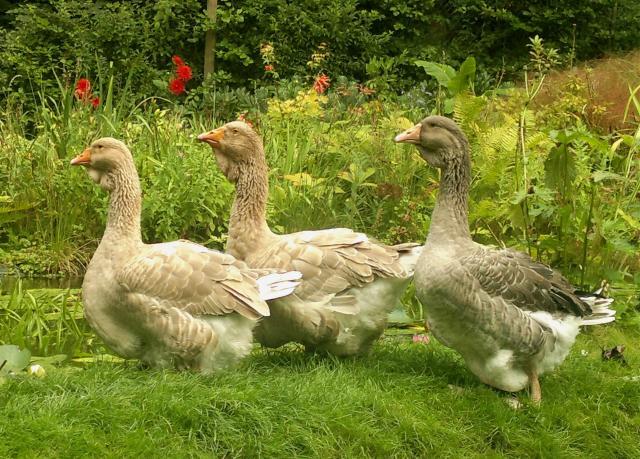
BUFF DEWLAP TOULOUSE PAIR WITH GREY GOOSE.
The above examples can be taken a stage further by combining the effects of the different genes. For example a female could have both the spotting gene and the buff gene in their recessive forms linked to her single Z chromosome. In this case she would appear as a Buff Pied and her most basic genotype written as; Z, W, sp, g. In the case of a Buff Pied male his most basic genotype would be written as Z, Z, sp, sp, g, g. If the male only had one recessive buff gene then he would visually be a grey pied split for buff. So these examples show the visual effects of these two recessive genes can be combined and work together.
Next we can look at the Blue gene (Bl) which has incomplete dominance and is not carried on the sex chromosome. Depending on the paired combination the visual effect is the same for males and females. By listing the possible pairings the visual appearance of the bird can be predicated.
bl, bl visual grey.
Bl, bl visual blue as the bird has only one dominant blue gene and the visual effect is partial.
Bl, Bl visual silver as the bird has a pair of dominant blue genes and the visual effect is even stronger which results in a paler blue which is referred to as Silver or Lavander.
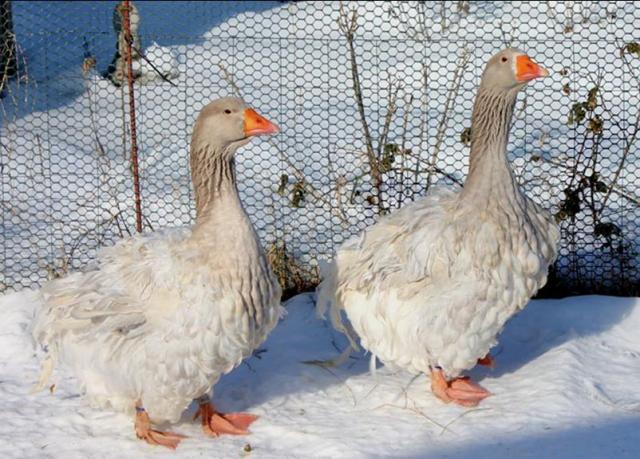
LAVANDER SEBASTOPOL PAIR OWNED BY VICKY THOMPSON
Once again the effects of the Blue gene changes when combined with the recessive forms of the Spotting and/or Buff gene. Therefore if it is combined with the Spotting gene in its forms to be visual then the results could be a Blue Pied or a Silver Pied. If it is combined with the visual form of the Buff gene then its Blue form becomes Lilac and its Silver/Lavander form becomes Cream. Once again it can be combined with the visual forms of the Spotting gene and Pied Lilacs and Pied Creams can be the result.
At this point three of the genes responsible for colour and pattern have been examined. However the final gene for Dilution can cause more complications. The Dilution gene (Sd) is like the Blue gene (Bl) in that its visual effects are incompletely dominant but it is also sex linked to the Z chromosome. Therefore if a grey female inherited the Dilution gene in its dominant form (Sd) then the visual effect would be a dilute grey often with white markings around the base of the beak. If a male inherited a single dominant dilution gene it also appears visually as a dilute grey. However if it inherits a double dose of the dilution gene in its dominant form then the visual effect is White. This effect is known as being Dimorphic, meaning the birds can be visually sexed by their colour. Males will be white and females a dilute grey and it is this gene that is responsible for the Pilgrim breed. In a single dominant dose it dilutes the colour and in its double dominant form the effect is strengthened and the bird appears visually White.
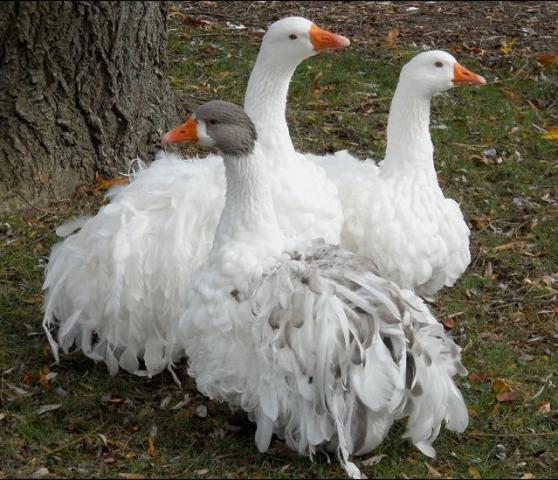
WHITE AND SADDLEBACK (PIED) SEBASTOPOLS OWNED BY VICKY THOMPSON
Where the Dilution gene becomes very complicated is when it is combined with the recessive form of the Spotting gene. If a male has one dominant dilution gene and one recessive Spotting gene then the bird will be visually Dilute but split for Pied. If a female has a dominant dilution gene and a recessive spotting gene linked to her Z chromosome then the bird is visually White. If a male inherits a double dose of the Dilution gene in its dominant form and a single recessive Spotting gene then it remains a Dimorphic White but split for pied. If the dominant pair of Dilution genes are combined with a pair of recessive Spotting genes then the male is visually White. It appears confusing but as both the Dilution and Spotting gene are both sex linked then it can be said that the bird is a visual pure White when all Z chromosomes carry the dominant Dilution gene and the recessive Spotting gene. In fact this is the reason white Sebastopols can be sexed at hatching. As the baby males have a pair of Z chromosomes then the dilution effect is stronger and their down appears paler than the females.
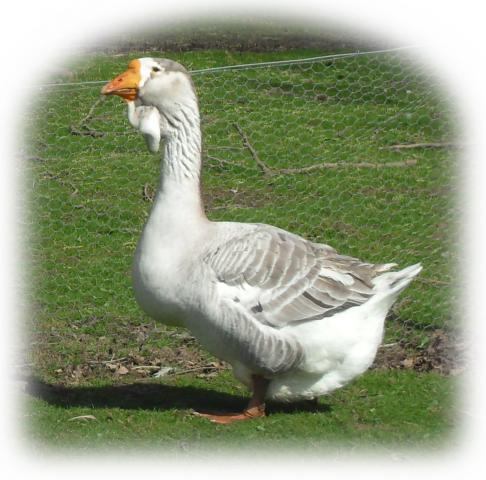
An unusual Dilute African Gander. The colour being due to a single Dilution gene and NOT a Blue gene (note white mask due to incomplete dominance).
Where this combination becomes more confusing is that a genetically White bird can have its other Blue and Buff genes masked. The bird may also be genetically Buff or Blue but the visual effect is hidden by the dominant effect of the Dilution gene. As an example the following is a genotype of a visually White male that is also Lilac; Z Z Sd Sd sp sp Bl bl g g.
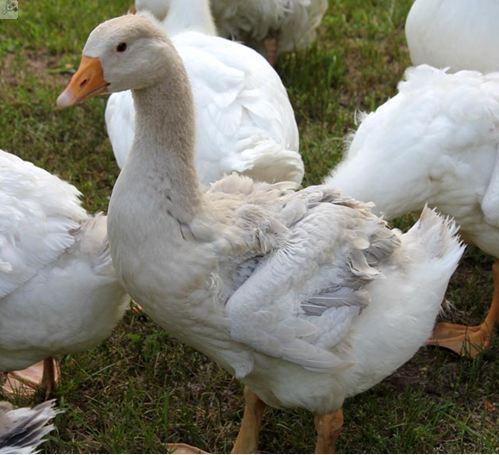
A RARE LILAC SEBASTOPOL GOSLING, BRED AND OWNED BY VICKY THOMPSON.
Although complex the knowledge of the four genes responsible for colour and pattern can enable the breeder to select for a specific pattern and colour. However due to the dominant effect of the dilution gene breeders should know the background of their bloodlines with white Sebastopols as these may also have the blue and/or buff genes in their genetic make-up. When selecting for a more unusual colour such as buff, then the breeder also has to maintain accurate records and a sound marking system as males which carrying a single recessive gene of this colour are visually identical to grey birds. By studying genetics the breeder opens up the possibilities for a wide variation of colours and coloured patterns in their Sebastopol breeding programme.
Last edited:





